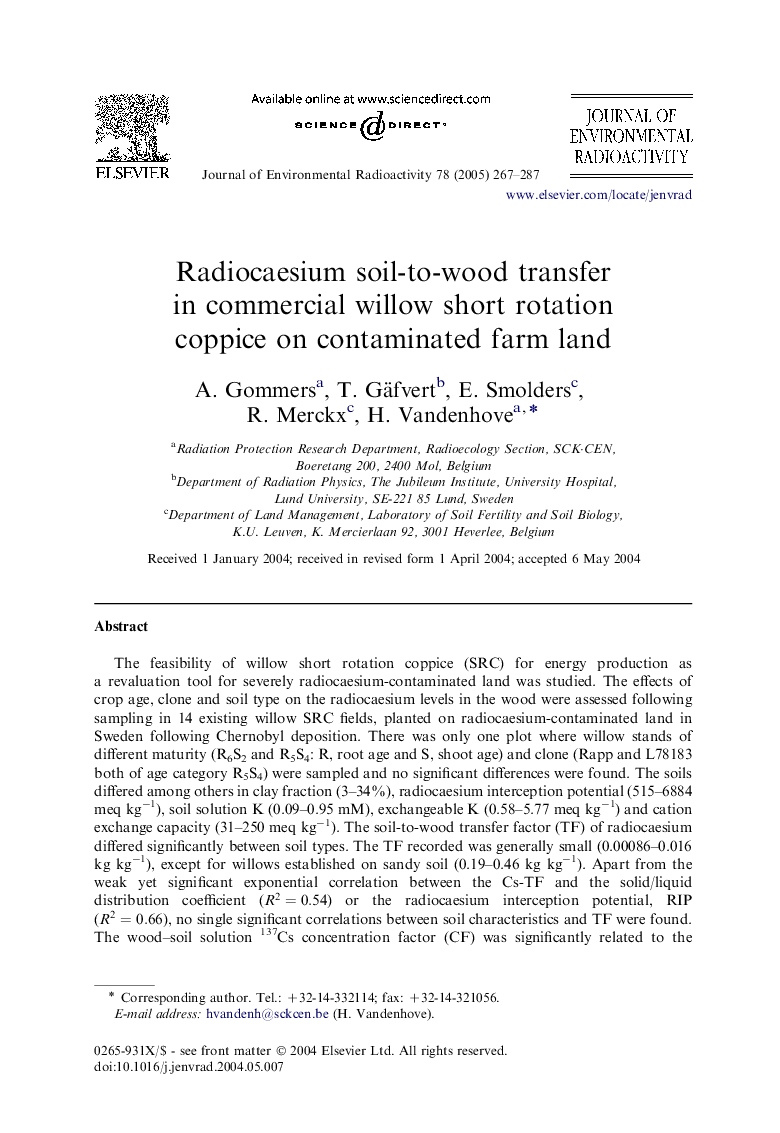| کد مقاله | کد نشریه | سال انتشار | مقاله انگلیسی | نسخه تمام متن |
|---|---|---|---|---|
| 10686828 | 1016892 | 2005 | 21 صفحه PDF | دانلود رایگان |
عنوان انگلیسی مقاله ISI
Radiocaesium soil-to-wood transfer in commercial willow short rotation coppice on contaminated farm land
دانلود مقاله + سفارش ترجمه
دانلود مقاله ISI انگلیسی
رایگان برای ایرانیان
کلمات کلیدی
موضوعات مرتبط
مهندسی و علوم پایه
مهندسی انرژی
انرژی هسته ای و مهندسی
پیش نمایش صفحه اول مقاله

چکیده انگلیسی
The feasibility of willow short rotation coppice (SRC) for energy production as a revaluation tool for severely radiocaesium-contaminated land was studied. The effects of crop age, clone and soil type on the radiocaesium levels in the wood were assessed following sampling in 14 existing willow SRC fields, planted on radiocaesium-contaminated land in Sweden following Chernobyl deposition. There was only one plot where willow stands of different maturity (R6S2 and R5S4: R, root age and S, shoot age) and clone (Rapp and L78183 both of age category R5S4) were sampled and no significant differences were found. The soils differed among others in clay fraction (3-34%), radiocaesium interception potential (515-6884 meq kgâ1), soil solution K (0.09-0.95 mM), exchangeable K (0.58-5.77 meq kgâ1) and cation exchange capacity (31-250 meq kgâ1). The soil-to-wood transfer factor (TF) of radiocaesium differed significantly between soil types. The TF recorded was generally small (0.00086-0.016 kg kgâ1), except for willows established on sandy soil (0.19-0.46 kg kgâ1). Apart from the weak yet significant exponential correlation between the Cs-TF and the solid/liquid distribution coefficient (R2=0.54) or the radiocaesium interception potential, RIP (R2=0.66), no single significant correlations between soil characteristics and TF were found. The wood-soil solution 137Cs concentration factor (CF) was significantly related to the potassium concentration in the soil solution. A different relation was, however, found between the sandy Trödje soils (CFÂ =Â 1078.8Â ÃÂ mKâ1.83, R2=0.99) and the other soils (CFÂ =Â 35.75Â ÃÂ mKâ0.61, R2Â =Â 0.61). Differences in the ageing rate of radiocaesium in the soil (hypothesised fraction of bioavailable caesium subjected to fast ageing for Trödje soils only 1% compared to other soils), exchangeable soil K (0.8-1.8 meq kgâ1 for Trödje soils and 1.5-5.8 meq kgâ1 for the other soils) and the ammonium concentration in the soil solution (0.09-0.31 mM NH4+ for the Trödje soils compared to 0.003-0.11 mM NH4+ for the other soils) are put forward as potential factors explaining the higher CF and TF observed for the Trödje soils. Though from the dataset available it was not possible to unequivocally predict the Cs-soil-to-wood-transfer, the generally low TFs observed point to the particular suitability for establishment of SRC on radiocaesium-contaminated land.
ناشر
Database: Elsevier - ScienceDirect (ساینس دایرکت)
Journal: Journal of Environmental Radioactivity - Volume 78, Issue 3, March 2005, Pages 267-287
Journal: Journal of Environmental Radioactivity - Volume 78, Issue 3, March 2005, Pages 267-287
نویسندگان
A. Gommers, T. Gäfvert, E. Smolders, R. Merckx, H. Vandenhove,